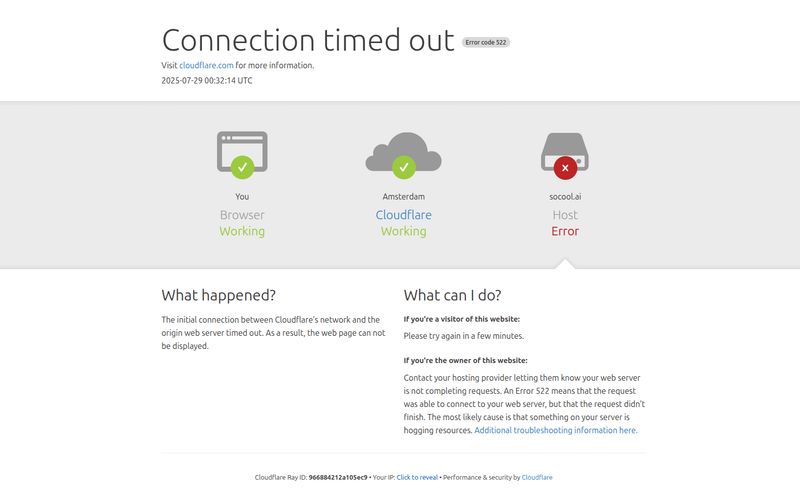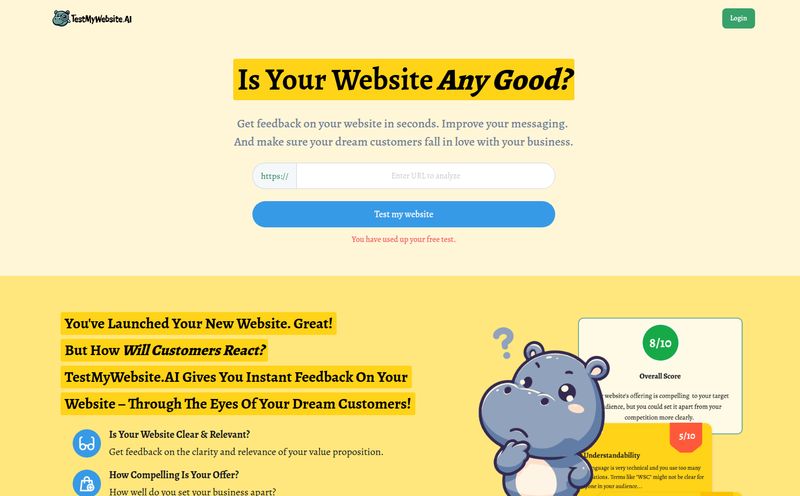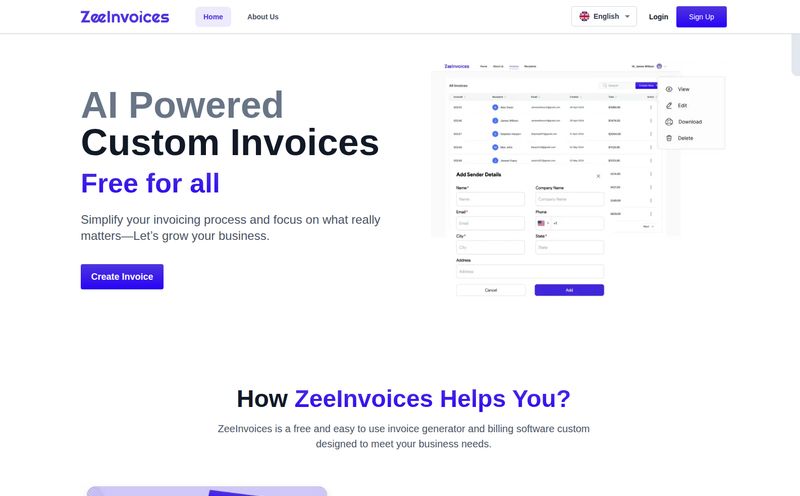As someone who lives and breathes web traffic and user experience for a living, few things make my eye twitch more than a terrible customer support experience. You know the one. You land on a site, a little chat bubble pops up with a stock photo of someone named 'Jane', and you spend the next ten minutes arguing with a glorified search bar that only understands three keywords. It's maddening.
For years, we've been promised an AI revolution in customer service, but mostly what we've gotten are clunky, frustrating bots that create more problems than they solve. I’d almost given up hope. Honestly. But every now and then, I stumble across a tool that makes me sit up and pay attention. This week, that tool was Jarbas AI.
The name sounds like something out of Iron Man, right? And the claims they make are just as bold. We're talking about resolving up to 90% of support demand automatically. Ninety percent. And making your human team 10x more productive. My inner cynic immediately went on high alert, but my inner tech nerd was intrigued. So, I did what I do best: I went digging.
So, What's the Big Deal with Jarbas?
First off, Jarbas isn't positioning itself as just another chatbot. That’s the key difference. They call their tech "autonomous AI agents." It’s a subtle but important distinction. A chatbot follows a script, a decision tree. It's like a choose-your-own-adventure book where all the endings are 'Please wait for a human agent.' An autonomous agent, at least in theory, is designed to understand, reason, and resolve issues on its own.

Visit Jarbas AI
Think of it like this: a chatbot is a receptionist with a FAQ sheet. An autonomous AI agent is like a highly-trained, junior support specialist who works 24/7, speaks every language fluently, and never needs a coffee break. It integrates with your knowledge base, learns from past interactions, and aims to provide a complete answer, not just deflect the query. Seeing companies like iFood and Stone on their homepage lends some serious credibility to this idea. These aren't small fish; they operate at a massive scale where inefficient support can be a death sentence.
The Features That Actually Matter
A flashy homepage is one thing, but the feature set is where the rubber meets the road. I was expecting the usual suspects, but a few things stood out.
Autonomous AI Agents are the Main Event
This is the core promise. The agents are built to handle the entire customer support lifecycle for a huge chunk of your tickets. From the initial query to the final resolution. The claim of handling 90% of requests is... ambitious. I've been in this game a long time, and that number is wild. But even if it only hits 60% or 70%, think about the impact. That's a revolutionary reduction in the noise that typically buries a support team, allowing them to focus on teh truly complex, high-touch issues that build real customer loyalty.
A Collaborative Inbox Optimized by AI
This part is crucial because it shows they haven't forgotten about the human team. Jarbas isn’t just about automation; it's about augmentation. The platform includes a collaborative inbox where the remaining 10% (or more) of tickets land. The AI is still present here, helping to sort, prioritize, and even suggest replies for the human agents. This is how they get to that '10x productivity' claim. It's not magic, it's just smart workflow. It's about giving your expensive, experienced human experts superpowers so they're not wasting time on password resets and 'where is my order?' tickets.
Wait, It Creates Content and Art Too?
Here’s the curveball. Jarbas also includes tools for AI content creation and even AI art generation. At first, I thought this was a strange add-on. A bit of a gimmick. But the more I think about it, the more it makes sense. Your support knowledge base needs constant updating, right? Your blog needs content to attract users. Your social media needs images. By bundling these AI tools, Jarbas is creating a more holistic 'AI assistant' for the entire company, not just the support department. It’s a clever, if unexpected, addition.
The Good, The Bad, and The Brutally Honest
No tool is perfect. Let's break it down without the marketing gloss.
The upside is obvious and massive. You get 24/7 omnichannel support, which is the new standard customers expect. You could see a dramatic drop in your support workload and a corresponding increase in team morale and productivity. And the ability to offer support in multiple languages without hiring a global team is a huge win for any company looking to scale internationally. Imagine waking up on a Monday morning to a clean support queue because your AI agents handled everything over the weekend. That's the dream.
Now for a dose of reality. This isn't a plug-and-play solution you can set up in five minutes. The platform's effectiveness hinges entirely on how well you set it up and train the AI agents. You need a solid knowledge base for it to learn from. Garbage in, garbage out. You'll also still need human oversight. For complex, sensitive, or high-value customer issues, you'll always want a human touch. And that's a good thing! The goal is better service, not zero human contact. Trust me, your customers will thank you for it.
So, How Much Does This AI Super-Team Cost?
Ah, the million-dollar question. If you go looking for a pricing page on the Jarbas site, you won't find one. This is pretty standard for enterprise-level B2B SaaS. It tells me the pricing is likely custom and based on your specific needs—how many support requests you get, which features you need, your team size, etc.
While the lack of transparency can be a bit annoying, it also means you're not paying for features you don't need. The only way to find out is to hit that 'Agendar demonstração' (Schedule a demo) button and have a chat with their team. My advice? Go into that call with your numbers ready: current ticket volume, average resolution time, and team size. That'll help you gauge the potential ROI.
Frequently Asked Questions About Jarbas AI
- What makes Jarbas different from a standard chatbot?
- The main difference is its goal. A chatbot is designed to deflect or answer simple questions based on a script. Jarbas uses 'autonomous agents' that aim to understand, reason, and fully resolve a customer's issue without human intervention, pulling from your entire knowledge base to do so.
- Can Jarbas AI handle support in multiple languages?
- Yes, multi-language support is one of its core strengths. It allows you to provide 24/7 support to a global customer base without needing to hire native speakers for every single language.
- Do I still need a human support team if I use Jarbas?
- Absolutely. And you should want one! Jarbas is designed to handle the high-volume, repetitive queries (up to 90% of them). This frees up your human experts to focus on complex, high-value, or sensitive customer issues where a human touch is essential.
- How much does Jarbas AI cost?
- Jarbas doesn't list public pricing. It operates on a custom, quote-based model. You'll need to schedule a demo with their team to get pricing based on your company's specific usage and needs.
- What kind of setup is involved?
- There's an initial setup and training process. The AI needs to be connected to your systems and fed your existing knowledge base, help center articles, and past support tickets to learn your business and how to best serve your customers.
Final Thoughts: Is It Time to Hire an AI Agent?
I started this with a healthy dose of skepticism, and while I still think the '90% resolution' claim needs to be tested in the real world, I'm walking away impressed. Jarbas represents a clear step in the right direction. It’s not just about cutting costs; it’s about fundamentally changing the structure of customer support. It's about elevating the role of human agents from ticket-closers to true customer advocates.
If you're a team lead or founder who's constantly feeling buried under the weight of your support queue, a tool like Jarbas is, at the very least, worth a demo. The era of the dumb chatbot is thankfully ending. The era of the autonomous agent is just beginning. And from what I can see, it's going to be a much, much better experience for everyone involved.



